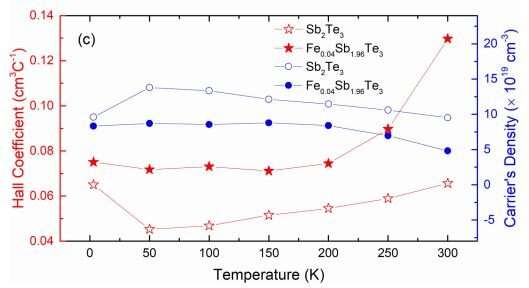Tuning the topological insulator Sb2Te3: Just add iron

Iron-doping of the topological insulator Sb2Te3 results in useful electronic and magnetic properties, quantified in a recent FLEET study at the University of Wollongong.
The researchers studied the magneto-transport properties of an iron-doped topological insulator (Fe–Sb2Te3).
After the material is doped via the addition of iron, its electronic structure changes significantly: multiple response frequencies emerge, in contrast to the single frequency detected for Sb2Te3 in its pure form, and carrier density and mobility are reduced.
"This improved understanding of the effects of doping on the topological insulator Sb2Te3 are critical to inform future possible use in low-energy electronics," explains project leader Xiaolin Wang.
Topological insulators (TIs) are novel materials that are neither electrical conductors, nor electrical insulators. Instead, a topological insulator is an insulator in its interior, but conducts along its edges (likened to a chocolate block wrapped in aluminum foil).
Topological insulators' unique Dirac surface states are attractive for electronic applications and potentially host a range of fascinating and useful phenomena.
In three-dimensional (3-D) topological insulators such as Sb2Te3, the surface electronic structure is entangled with the internal (bulk) electronic structure and, consequently, both aspects need to be understood at the fundamental level.
Unresolved questions concerning the effect of metal doping of Sb2Te3 is related to one of the most fascinating transport properties in topological insulators: the quantum anomalous Hall effect (QAHE).
QAHE describes an effect that was once "unexpected" (ie, anomalous): quantization of the transverse "Hall" resistance, accompanied by a considerable drop in longitudinal resistance.
"It's an area of great interest for technologists," explains Xiaolin Wang. "They are interested in using this significant reduction in resistance to significantly reduce the power consumption in electronic devices."
The study of magnetic-doped topological insulators seeks to find the optimal set of dopants, magnetic order, and transport properties in order to:
- Achieve a higher (near ambient) QAHE onset temperature
- Eliminate unwanted features in the electronic structure introduced by the transition-metal dopant that are detrimental to performance.
Findings in detail
This new study reports the electronic effects of doping Sb2Te3 single crystals with iron, via magneto-transport experiments and complementary theoretical calculations.
Doping the topological insulator Sb2Te3 with iron results in:
The material's electronic band structure changing significantly
- Introduction of multiple Fermi pockets, including two that are highly angle-dependent
- Reduced carrier density and mobility.
Using theoretical calculations, the researchers identified an additional bulk hole pocket introduced in the electronic structure, originating from chemical distortion associated with the iron dopant.
Two angle-dependent oscillation frequencies were identified, related to two Fermi pockets.
Moreover, the landscape of the electrons energy-momentum relationship changes via iron doping thus indicating a rich complexity in the underlying electronic structure.
Experimentally, both doped and undoped samples are hole-carrier dominated; however, iron doping also reduces the carrier density and mobility.
More information: Weiyao Zhao et al. Quantum oscillations in iron-doped single crystals of the topological insulator Sb2Te3, Physical Review B (2019). DOI: 10.1103/PhysRevB.99.165133
Journal information: Physical Review B
Provided by FLEET



















